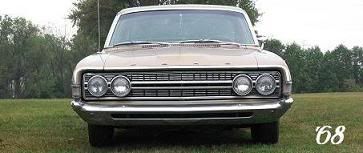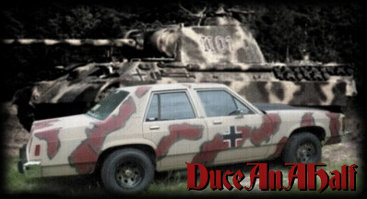I was browsing through craigslist the other night and found a set of 68-69 ford marine heads off of a 302. The guy says they are original to the boat/engine and were used in freshwater. For $50 are they worth buying? I know they would need rebuilding, but I figure they would be torquey heads to go on a marine engine and that matches well with a 302 in a 3500lb car. Im working on getting a casting number, all I have so far is: # 302 E 8K16
 |
Announcement
Collapse
No announcement yet.
New-Old Heads?
Collapse
X
-
I'd say yes if they are any good. Even the 2-bbl heads flow as well as E7TE's, and if these marine heads are similar to the 302 4-bbl C8OE-F heads then they are even better (but may push compression up a little too much).1990 Country Squire - under restoration
1988 Crown Vic LTD Wagon - daily beater
GMN Box Panther History
Box Panther Horsepower and Torque Ratings
Box Panther Production Numbers
-
I saw them for cheap and thought it might be worth it, just to be different even. I'll see if I can take a look at them this weekend.
Here is what I know so far:
they came out of a 302 that was on my boat, I had a leaky head gasket
and a set of new heads, so i didnt bother to rebuild these, but i know
some folks like original older heads for
thier car so i didnt toss them.
They are oily so not rusted but have some surface corrision from
sitting around for a few months.
This is incidental if being rebuilt.
They worked fine - tho i did have low psi in one cyl. so thats why i
say they would have to be rebuilt,
no cracks or anything showing.
# 302 E 8K16
someone told me these MAY be a 69 head, i dont have the card handy for
years and number matches,
but the boat is a 1968 and the engine is original, there is a chance
the heads were once replaced
but i see no signs of that. the boat has low hours, was on a fresh
water lake.Last edited by nitroracer; 02-04-2007, 11:08 PM.-Matt
1968 Fairlane 500 - 1998 Camaro Z/28

Comment
-
Those are probably regular 2-bbl heads, but they still flow like E7TE's.1990 Country Squire - under restoration
1988 Crown Vic LTD Wagon - daily beater
GMN Box Panther History
Box Panther Horsepower and Torque Ratings
Box Panther Production Numbers
Comment
-
Look in the water passages. I'll bet they're rusted and scaly like you wouldn't believe. Marine heads are very much a crap shoot, half the time they get replaced because the water jackets rot through and start pumping water into the engine. Head gaskets seldom fail, its often the head thats fried when it starts getting water in the motor. I'd pass personally.86 Lincoln Town Car (Galactica).
5.0 HO, CompCams XE258,Scorpion 1.72 roller rockers, 3.55 K code rear, tow package, BHPerformance ported E7 heads, Tmoss Explorer intake, 65mm throttle body, Hedman 1 5/8" headers, 2.5" dual exhaust, ASP underdrive pulley
91 Lincoln Mark VII LSC grandpa spec white and cranberry
1984 Lincoln Continental TurboDiesel - rolls coal
Originally posted by phayzer5
I drive a Lincoln. I can't be bothered to shift like the peasants and rabble rousers
Everything looks like voodoo if you don't understand how it works
Comment
-
There is no difference in flow between 2v and 4v versions of 289/302/351W heads for the same year. Smog versions loose flow on the exhaust side.Originally posted by TiggieI'd say yes if they are any good. Even the 2-bbl heads flow as well as E7TE's, and if these marine heads are similar to the 302 4-bbl C8OE-F heads then they are even better (but may push compression up a little too much).
Do those heads have the smog hump in the exhaust port? The 8K16 means that they are 1969 model year heads. The castings were the same for 68 and 69. The 4V 1968 heads would have a 4V instead of the E cast into them. The primary difference in the 302 4V head is the 54cc combustion chamber for higher combustion. All other 302 heads including those E marked heads you have are the standard 302 chamber.
Because of the pressed in positive stop studs, probable worn guides and non-hardened seats, even $50 is no bargain. Stick with late model heads.
Comment
-
I thought the postive-stop studs started until 1970 on the small blocks.Originally posted by MercracerBecause of the pressed in positive stop studs, probable worn guides and non-hardened seats, even $50 is no bargain. Stick with late model heads.1990 Country Squire - under restoration
1988 Crown Vic LTD Wagon - daily beater
GMN Box Panther History
Box Panther Horsepower and Torque Ratings
Box Panther Production Numbers
Comment
-
All "Windsor" small blocks with the exception of the HiPo 289 had positive stop studs until the implementation of the bolt down pedestal rockers in the mid 70's.Originally posted by TiggieI thought the postive-stop studs started until 1970 on the small blocks.
Brand X had non-positive stop press in studs.
Comment
-
I don't mean to pick here, but are you sure? They were surely adjustable on on my '64 1/2 D-Code 289. They weren't positive stop as I had to adjust them when I got it. Tighten the loose ones until they stop clacking and then 1/4 turn, for the tight ones loosen until they just start clacking and then follow the procedure for the loose ones.Originally posted by MercracerAll "Windsor" small blocks with the exception of the HiPo 289 had positive stop studs until the implementation of the bolt down pedestal rockers in the mid 70's.
You might want to check out these sites:
From The Ford V8 Engine Workshop - 90° V Small Block:
289 engines built before mid-1966 and all 289 HiPer engines use a conventional stud mounted rocker arm. The rocker arm is held in alignment with the valve stem by a close tolerance pushrod slot machined into the cylinder head. These engines use hardened pushrods. This scheme is fully adjustable and may be used successfully with mechanical cams.
289 engines built after mid-1966 and 302 engines use a rail-type rocker arm. These rocker arms have ears that extend downward, forming a rail or channel over the valve stem. This rail maintains proper alignment. The pushrod passes through a loose tolerance hole in the cylinder head, resulting in a cheaper assembly.
At high RPM, however, these rockers can jump the track, loosing alignment with the valve stem and resulting in potentially serious engine damage. These engines do not require hardened pushrods. This scheme was fully adjustable until 1970 when the studs were changed to incorporate a positive stop. The rocker arm nut is no longer used to adjust the valve clearance. Rather it is simply tightened down. Longer or shorter pushrods are selected to adjust the clearance. Since these are non-adjustable they can not be used with mechanical cams.
From Comp Cams Ford Tech Information
Positive Stop Stud
This type stud was used on 1969-76 302 and 351W engines, as well
as 1968-72 429 engines with hydraulic cams. They do not allow for lifter
adjustment and work only with smaller cams when the dimensions of the
engine (block, head deck height, etc.) remain close to stock. They also
don’t work on solid lifter cams.
COMP Cams® offers an adjustment kit (Part #4610-16 on page 276) for
use with the stock positive stop studs. For high performance applications,
this type of stud should be replaced with the more conventional screw-in
type, along with the pushrod guide plates.
Conventional Stud
The conventional stud is usually found on early model 221-302 engines
and all engines originally equipped with a solid lifter camshaft. This type
of stud uses a locking nut or polylock to keep the valve adjustment
fromchanging.
They may be wrong, but from my experince with the early engines shows they are correct. I know the ones from 1970-up are positive stop per my uncle's '70 Mustang. Am I overlooking something here?1990 Country Squire - under restoration
1988 Crown Vic LTD Wagon - daily beater
GMN Box Panther History
Box Panther Horsepower and Torque Ratings
Box Panther Production Numbers
Comment
-
SOME OF THE MARINE HEADS WERE DIFFERENT THAN ORDINARY PRODUCTION. That is because marine stuff is run at higher speeds for extended periods. Some of the last 302 marine stuff had a version of the GT40s on them.Originally posted by nitroracerSo if they turn out to be D0OE castings or C9 castings, worth the $50 but otherwise not? They have the rockers/springs probably not pushrods though.Scars are tatoos of the fearless
Comment
-

Originally posted by turbo2256bSOME OF THE MARINE HEADS WERE DIFFERENT THAN ORDINARY PRODUCTION. That is because marine stuff is run at higher speeds for extended periods. Some of the last 302 marine stuff had a version of the GT40s on them.
The heads on my car right now are E8JE heads off a marine 302. they have 2 GT-40 ridges cast into the fronts.http://secondhandracing.com/Home.aspx
http://secondhandradio.com/
R.I.P. Jason P Harrill 6-12-06

http://www.grandmarq.net/vb/showthread.php?t=5634
Comment
-
Hell I have a set of never on an engine D0OE heads I'll sell you if you want them that bad. They need a rebuild but they're probably in much better shape than a marine head. They were rebuilt like 18 years ago but have a fair amount of rust from sitting since that time. I'd still not buy a used raw water cooled marine head. Usually they rot out inside, and thats why water gets in the motor. People blame it on the head gasket, and change the head "just cuz its old" and the problem is fixed. As often as not, changing the head is what fixed the problem, not the gasket. All things considered, you'd be better off spending your money on a better head. The D0 casting in stock form isn't much better than a stock E7 head, and they do not flow as well as a GT40 out of the box. They have a lot of potential from what I hear, but between the work involved getting them to that point, plus all the stuff you'd have to do in order to make them truly suitable for use in a modern car with unleaded fuel, its barely worth it. I bought the D0 heads planning to do all that stuff. They're sitting around collecting dust, and I have ported E7 heads now.Originally posted by nitroracerSo if they turn out to be D0OE castings or C9 castings, worth the $50 but otherwise not? They have the rockers/springs probably not pushrods though.86 Lincoln Town Car (Galactica).
5.0 HO, CompCams XE258,Scorpion 1.72 roller rockers, 3.55 K code rear, tow package, BHPerformance ported E7 heads, Tmoss Explorer intake, 65mm throttle body, Hedman 1 5/8" headers, 2.5" dual exhaust, ASP underdrive pulley
91 Lincoln Mark VII LSC grandpa spec white and cranberry
1984 Lincoln Continental TurboDiesel - rolls coal
Originally posted by phayzer5
I drive a Lincoln. I can't be bothered to shift like the peasants and rabble rousers
Everything looks like voodoo if you don't understand how it works
Comment

Comment